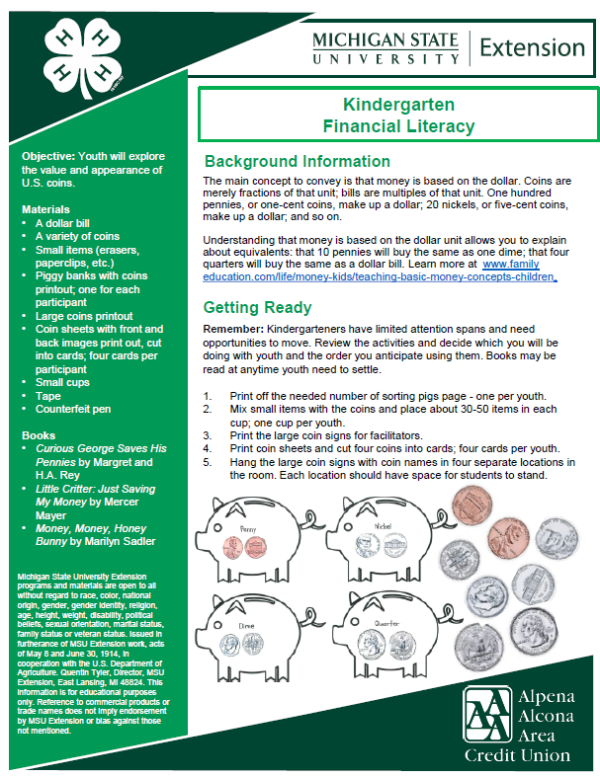
Kindergarten Financial Literacy
DOWNLOADAugust 19, 2025 - Tracy D'Augustino, Michigan State University Extension, and Kelly Alexander, Alpena Alcona Area Credit Union
Objective
Youth will explore the value and appearance of U.S. coins.
Materials
- A dollar bill
- A variety of coins
- Small items (erasers, paperclips, etc.)
- Piggy banks with coins printout; one for each participant
- Large coins printout
- Coin sheets with front and back images print out, cut into cards; four cards per participant
- Small cups
- Tape
- Counterfeit pen
Books
- Curious George Saves His Pennies by Margret and H.A. Rey
- Little Critter: Just Saving My Money by Mercer Mayer
- Money, Money, Honey Bunny by Marilyn Sadler
Background Information
The main concept to convey is that money is based on the dollar. Coins are merely fractions of that unit; bills are multiples of that unit. One hundred pennies, or one-cent coins, make up a dollar; 20 nickels, or five-cent coins, make up a dollar; and so on.
Understanding that money is based on the dollar unit allows you to explain about equivalents: that 10 pennies will buy the same as one dime; that four quarters will buy the same as a dollar bill. Learn more at www.familyeducation.com/life/money-kids/teaching-basic-money-concepts-children
Getting Ready
Remember: Kindergarteners have limited attention spans and need opportunities to move. Review the activities and decide which you will be doing with youth and the order you anticipate using them. Books may be read at anytime youth need to settle.
- Print off the needed number of sorting pigs page - one per youth.
- Mix small items with the coins and place about 30-50 items in each cup; one cup per youth.
- Print the large coin signs for facilitators.
- Print coin sheets and cut four coins into cards; four cards per youth.
- Hang the large coin signs with coin names in four separate locations in the room. Each location should have space for students to stand.
Procedure
Read statements in italics.
Ask youth, “Why is money important?” Some answers that you may share or may be shared include:
- “Money is a trading system for goods and services that everyone is willing to accept. We use money to get ‘stuff.’”
- “Only governments can print or make money such as printed dollar bills and minted coins.”
- Using a counterfeit pen, draw on a dollar and on paper, show how the dollar printed by government reacts differently.
- “Everyone can earn money by working a job.”
Tell youth to raise their hands if they know what money looks like.
- “Great, you are going to sort a cup of items into two piles, one that is money and one that is not money.”
Give everyone a cup of items and allow time for the youth to sort the items. Wander around and see how youth are doing. Have everyone place the not money items back in their cup.
Tell youth to look at your money. “These are all coins.” Hold up the dollar bill. “Money in the United States, where we live, is based on the dollar. There are four main types of coins. Each is part of a dollar.”
Begin the Money Hop activity. Tell everyone to stand up and spread out to make sure you have room to move. “Stretch out your arms and make sure you are not be able to touch anyone. These are the four types of coins we use most often: penny, nickel, dime and quarter.” Show youth each coin and tell them to hop the appropriate number of times based on the following and count aloud for each hop:
Penny = $0.01 – Everyone hop once
Nickel = $0.05 – Everyone hop five times
Dime = $0.10 – Everyone hop 10 times
Quarter = $0.25 – Everyone hop 25 times
- Ask youth, “which coin has the most value? The most hops.” Have youth return to their seats.
Tell you to look at their coins and ask, “Do all the coins you have look the same? How are they different? Is there a difference in size, pictures, edge, color? The differences you see and feel tell us what coin they are.”
Begin the piggy bank activity. Give each youth a piggy bank sorting sheet and tell youth they are to sort their coins into the piggy banks on the sheet. Wander around and check how youth are doing. After the coins are successfully sorted, have youth place the coins back into their cup and collect the cups and sorting sheets.
Begin the Money Mice Match game. “You are all mice, you must move quietly around the room. Loud mice are captured and must sit down.” Point out that one coin is in each location of the room. Station an adult at each location with extra coin signs that do not match their sign. Adults will need to swap cards collected at their station as the game progresses. Give each youth a coin card. When the game begins, each youth (mouse) is to walk quietly around the room to find the sign that matches their coin. The student shows their coin to the adult and gets a new card from that adult. Remind youth that the instructor is listening, “if they hear you, you will have to sit down.” Students repeat as time allows.



 Print
Print Email
Email




